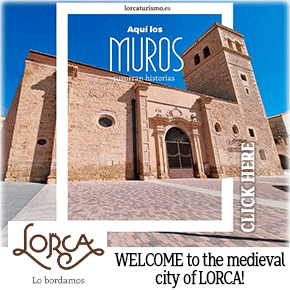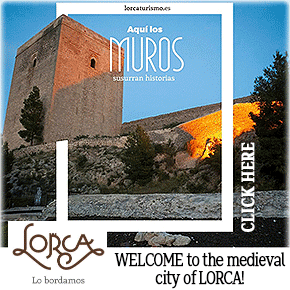La Bastida Totana
La Bastida is an important Argaric settlement
La Bastida is an important Argaric settlement in Totana and is frequently open for guided visits at weekends, with the times varying according to the time of year.
Visits for groups can be arranged at alternative times by prior arrangement.Reservations for all visits can be made at the Totana tourist office in person, by telephone on 968 418153 or by email at turismo@totana.es.
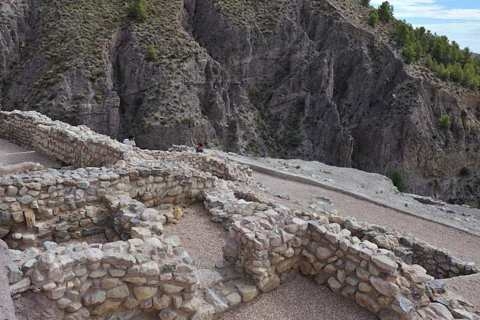
Tours are in Spanish, although English speaking visitors can register with the tourist office and once a group has been formed an English language visit can also be arranged. Group bookings can also be arranged with an English speaking guide. Directions to the site are given at the bottom of the article.
La Bastida, Totana
La Bastida (Totana, Murcia) is one of the most important Argaric Culture sites in Spain, the Argarics a Bronze Age Culture predominant in the South-eastern area of modern-day Spain between 2200BC and 1550BC, with sites in the Region of Murcia, Almería, Granada, Alicante and Jaén.
Murcia has several important Argaric sites, with Lorca, Pliego and Totana all containing significant remains.
The Bronze Age was an era of major technological advancement for mankind, developments in metallurgy permitting society to gather into larger settlements and undertake more intense agricultural production, allowing specialisation and a social hierarchy to develop, as production and distribution of finished goods, raw materials and foodstuffs was controlled.
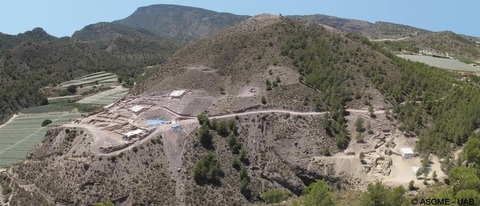
This culture presents many challenges for archaeologists as little is known about where it originated or why Argaric sites were abandoned. What is known is that this was a sophisticated culture, with a distinct hierarchical structure, which imposed rigid control over its three tier class system. Work was carried out by specialised craftsmen and society appears to have been administered by a ruling class with significant communication between different settlements.
For more details about the society, its culture, distribution, burials and where to find out more about it, Click the Argaric Culture in Murcia.
The settlement of La Bastida is located on the side of the Sierra de la Tercia, above the Barranco Salado and the Rambla of Lébor, 6km from the urban centre of Totana.
This area has attracted the attentions of mankind since early prehistory, with earlier pre-historic sites showing occupation of the area at Campico del Centeno, Cueva de los Blanquizares, Campico de Lébor, Cabezo de Juan Clímaco, Cejo del Pantano and La Serrecica
This site covers an area of 4 hectares, the current areas being recovered and excavated by archaeologists located on the lower levels of the site representing just 15% of the total area.
Its location is typical of Argaric settlements, the selection of a site giving strategic advantage, and natural protection: in this case two sides of the site are naturally inaccessible, close to water and giving control of communications routes and farmlands. Argaric settlements were clearly linked, the smaller settlements dependent (it is believed they operated as satellite sites, each with their own specific task) on the larger, control clearly exercised over the distribution of materials and food from a central point. The fact that 1500 grinding implements have been found in La Bastida and yet not a single agricultural implement clearly shows that La Bastida stored and ground grain which was farmed in nearby areas, distributing it from this one central point which controlled the food supply to the satellite settlements.
La Bastida is close to the Guadalentin Valley, but hidden from it, on a sharp, conical hill, with natural defenses making it accessible only from one entry point.
The site visitable today has been damaged over the centuries which have elapsed since it was abandoned, the eastern and southern sides of the site affected by erosion from the ramblas which protected it, and was also further damaged by a programme to replant pine trees in the 1970’s. Primitive excavations carried out in the 19th and 20th centuries and the large number of digs carried out by private individuals have also damaged some archaeological evidence, but the sheer scale of the site is yielding important evidence which is helping archaeologists to piece together more about this unique culture.
La Bastida is exceptional because of its size and fortifications, a combination which points to its position as an important town within the Argaric 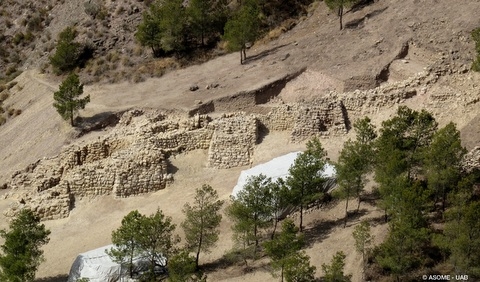 culture, and as a base from which the upper echelons of Argaric society would have controlled a territorial area.
culture, and as a base from which the upper echelons of Argaric society would have controlled a territorial area.
There are four larger sites known throughout the area covered by the Argarics: El Argar in Almería, the first site to be excavated and from which the culture derives its name, Lorca, about which little geographical data exists as the main settlement is buried beneath the existing city, but which has yielded a number of burials during repair and construction work, Pinos Puente in Granada and La Bastida in Totana.
A little history of the excavations of the site.
The site was first discovered by civil engineer Rogelio de Inchaurrandieta in 1869, and as part of his exploratory work he brought in 3 day labourers and in 3 days they dug up 20 graves. Unfortunately, his finds have disappeared, although he did make methodical notes about the locations of the graves, albeit not in the intensely detailed fashion adopted by modern archaeologists.
He was followed by the Belgian brothers, Henri and Louis Siret, who were carrying out excavations on Argaric sites in Almería and were responsible for finding and naming the first major settlement discovered, El Argar. They read about the findings at La Bastida, which appeared very similar to the remains they themselves were uncovering at various locations in Almería, and sent their own foreman to La Bastida in 1886 to excavate. This excavation uncovered 13 graves.
During 1944 and 1945, further excavations took place, followed by another in 1950. Unfortunately, clandestine excavations have also removed a large amount of evidence from the site.
The current excavations are being undertaken by the University of Barcelona, under the directorship of Vicente Lull, the foremost authority on the Argaric culture, who has also excavated other sites including that of El Argar.
The first excavations took place between the end of 2008 and 2009, focusing on a complete survey of the 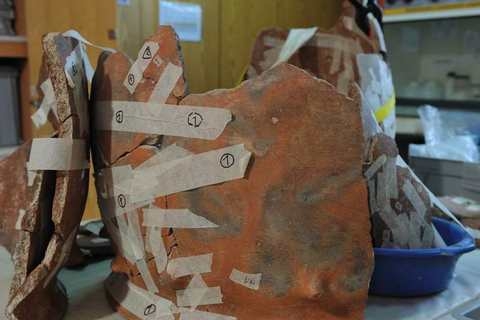 site, and superficial cleaning of the top areas, followed by the “re-excavation” of the areas first explored during the 20th century. These excavations comprised the areas visible to visitors today, and have revealed a number of buildings, some of them quite large by Argaric standards, as well as a circular water storage embalse.This stored 300,000 litres of rainwater and provided viatal clean water sources, although had to be cleaned out regularly to prevent it becoming silted up.
site, and superficial cleaning of the top areas, followed by the “re-excavation” of the areas first explored during the 20th century. These excavations comprised the areas visible to visitors today, and have revealed a number of buildings, some of them quite large by Argaric standards, as well as a circular water storage embalse.This stored 300,000 litres of rainwater and provided viatal clean water sources, although had to be cleaned out regularly to prevent it becoming silted up.
The areas currently under excavation date from a little before the year 2000BC and from the period of major activity between 1800 and 1600 BC.
It’s believed from these latest excavations that the town could have been home to up to 1000 occupants at its peak, an exceptional density of population during the Bronze Age and points to La Bastida being an important centre which gathered together materials and resources produced in other areas.
This hypothesis is further borne out by excavations carried out on the fortifications discovered on the north-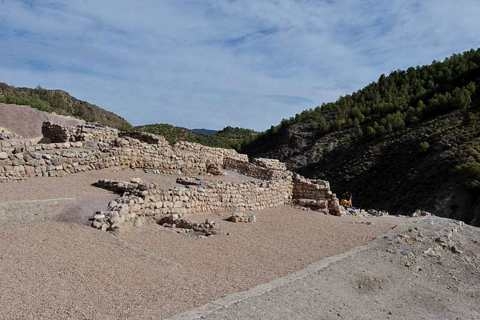 eastern corner of the site, which demonstrate a substantial fortified entrance to the settlement, changing the history of the Argaric Culture documented to date by yielding a construction date of 2200BC.
eastern corner of the site, which demonstrate a substantial fortified entrance to the settlement, changing the history of the Argaric Culture documented to date by yielding a construction date of 2200BC.
They also generate a large volume of unanswered questions, demonstrating a level of military technology unknown on the Iberian peninsula during this epoch, the main question being how did they obtain this technology?
One of the great unknowns relating to the Argaric culture is where these people actually came from. There are schools of thought which point to a natural development of indigenous populations, impulsed by the acquisition of technology from external sources which gave them an advantage over other indigenous inhabitants, or other schools which believe their technology was brought to these shores from other more developed populations in the East settling in these territories.The fact that the major Argaric settlements all date from the same period gives greater credibility to the second theory and it is hoped that some genetic link can be ascertained at some point.
The scale of the fortifications indicate a warrior society and were substantial, enclosing the residential areas inside a strong protective wall, and there is no evidence that the fortificatins were ever breached during the 700 year occupation of the site.
Argaric burials at La Bastida.
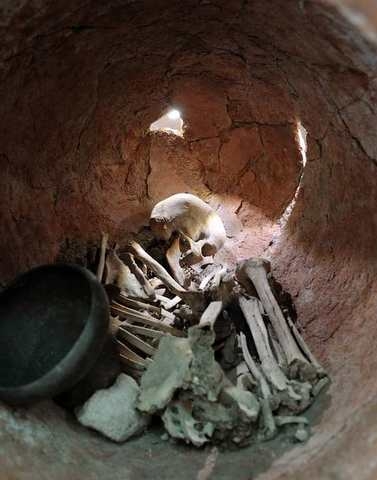 Whilst the excavation of settlements can yield valuable demographical evidence, the most important evidence about the Argaric culture comes from burials, providing a wealth of information about the people themselves, their technology, social structure, their diet, their health, life expectancy, clothing and ultimately, their decline.
Whilst the excavation of settlements can yield valuable demographical evidence, the most important evidence about the Argaric culture comes from burials, providing a wealth of information about the people themselves, their technology, social structure, their diet, their health, life expectancy, clothing and ultimately, their decline.
Burial practices are fairly uniform throughout the culture, the majority of the deceased interred under the floor of the houses in which they lived, in individual graves. Occasionally graves containing two skeletons are found, one unique grave yielding the remains of two men, a very unusual situation as many of the double burials are male/female. Within this culture burials have been found in which young are interred with old and there is no indication of religious rite other than the ritual of burial itself.
Generally the corpse was flexioned, ie knees drawn up onto the chest, so that it took up the least space possible, and generally the heads are positioned facing south or west.
There are four main forms of burial in Argaric sites: covachas which are cut out of the rock, pits dug into the earth, cists constructed with slabs or masonry and ceramic urns.
Bodies were not cremated, but buried intact, accompanied by grave goods which clearly help to define the social status of the individual.
Pre 1800BC adult male burials of high standing frequently include a long dagger or short sword, a halberd, ceramic vessels and ornaments, whilst women frequently carried a dagger or knife and an awl (an awl is a long, pointed spike, used for piercing holes in leather or textiles).
From 1800 BC onwards, longer swords start to appear in the male burials, whilst the females have diadems, knives and an awl.
In the second level of the social hierarchy the men frequently had a dagger or axe, the women a dagger/knife and awl, along with ceramic and metal accessories.
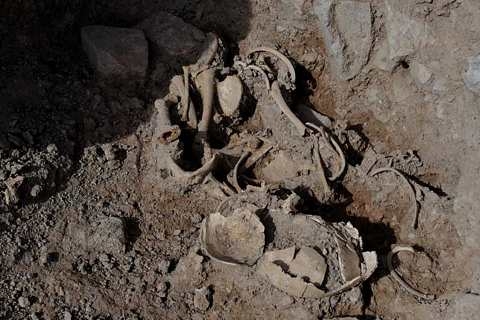 As time progresses, there is increased evidence of sophistication in artefact manufacture and a distinct difference in the life expectancy of those in graves with more important grave goods. One of the most important skeletons uncovered at the La Bastida site in Totana shows clear evidence of care, the body that of a woman in her seventies presenting evidence of falls, and broken bones which had mended, as well as multiple childbirths.
As time progresses, there is increased evidence of sophistication in artefact manufacture and a distinct difference in the life expectancy of those in graves with more important grave goods. One of the most important skeletons uncovered at the La Bastida site in Totana shows clear evidence of care, the body that of a woman in her seventies presenting evidence of falls, and broken bones which had mended, as well as multiple childbirths.
Interestingly, the later burials show increased dependence on a more sedentary lifestyle, as evidenced by the increased number of grinding implements and the higher number of artesan manufactured items, but also an increased infant mortality rate, a limited diet and crowded population centres leading to more younger deaths.
Most of the burials currently under excavation in the site at La Bastida, belong to the middle class, which represented around 50% of the population. Studies into the grave goods of Argaric society have revealed that around 10% of the population belonged to the upper, or ruling classes, 50% to the middle classes, ie artesans, and warriors, those with a clear skill and a participation in the society, and 40% who were clearly either slaves, labourers or servants.
These middle classes were buried with the tools of their trade, their personal possessions and items used in their daily lives, a combination of ceramics, tools made of bone, metal and stone, grinding stones for the production of flour, weapons, jewellery, buttons, and even seeds.
Argaric Ceramics
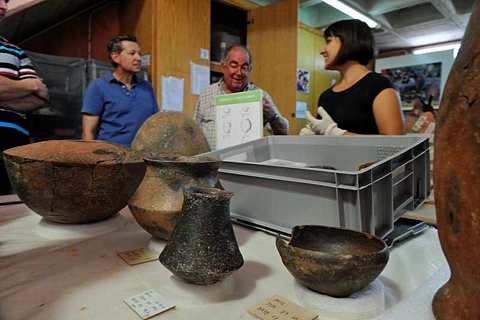 Ceramics are one of the most important and frequently recovered elements of Argaric burials.
Ceramics are one of the most important and frequently recovered elements of Argaric burials.
They tend to follow 8 universally defined forms, with simple drinking vessels, storage vessels for liquids, such as honey, or solids, larger vessels for wheat or barley, cooking vessels and ceramic urns used for burials.
A very interesting comparison of the volumes of the vessels indicates marked uniformity, showing a standardised form of measurement. It is believed that the measurements sytem is another form of control, as food was clearly measured for distribution and storage.
At this point in time the potters wheel was unknown, so ceramics were fashioned using a coiled system, then smoothed into standard shapes and fired in pits. Analysis has shown that ceramics were fired at around 700 degrees centigrade.
Blackening is common due to the firing method used and smaller pieces often have a polished finish, achieved by rubbing the surface with a piece of cane, or sometimes a smooth stone. Decoration is very infrequent, the majority of pieces lacking embellishment of any sort.
It is interesting to note that finished ceramics are known to have been transported from one area to another, as although ceramics were fired in situ, there is evidence of them being transported from place to place. In La Bastida, for example, some of the ceramic pieces have come from Almería, distinctly identifiable by the composition of the clay used.
Visitors to La Bastida are able to enjoy at first hand the processes followed by restorers as they recreate the past, rebuilding and restoring these ceramics. It’s a fascinating, and privileged insight into the work undertaken by archaeologists and really helps to bring this history back to life.
Tools and household items
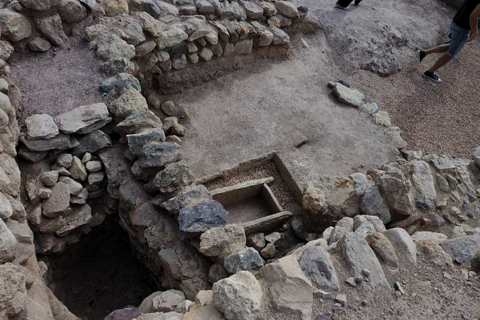 A common item discovered is a hand grinding stone, a vital tool used in the everyday task of grinding cereal crops. Barley was the main crop, and a small amount of wheat, although barley pre-dominated.
A common item discovered is a hand grinding stone, a vital tool used in the everyday task of grinding cereal crops. Barley was the main crop, and a small amount of wheat, although barley pre-dominated.
Its likely that the barley was ground using a wooden tool, against the stone surface of the mills. Grinding stones at La Bastida were imported from natural sites between 10 and 30km away.
Other tools found include maces, hammers, fragments of a mould for making metal items, anvils, sharpeners, hammer stones, grinding stones. polishing stones, axes and hatchets.
Stone axes were common, particularly in the predominantly agricultural settlements, stone elements inserted into wooden handles, or chipped flint inserted into a wooden structure to make sickles, and threshing boards.
Other objects frequently found related to textile production, weights and Spindle whorls with a central hole are both common finds.
Bone, ivory and antlers.
Bone, ivory and antlers are also commonly used materials, mainly obtained from domestic animals.
Awls and needles, chisels and smoothers were made using a process of breaking, sawing, and polishing bones from sheep, goats or cattle, used to perforate or join textiles, basketwork or linen. Bone also appears to have been used in scraping hides, and as buttons, as well as in decorative objects of personal adornment.
Metallurgy
The main mining areas for minerals such as copper were in Almeria, and there is clear evidence of 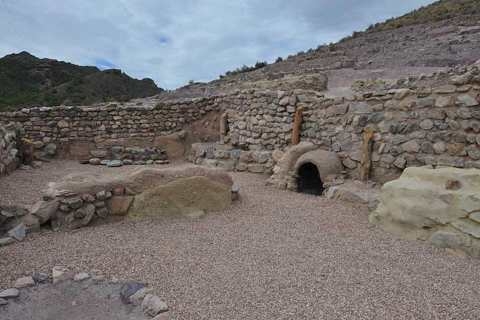 metallurgical activity in La Bastida, although it appears that the materials were transported to the town in ingot form or raw mineral form.
metallurgical activity in La Bastida, although it appears that the materials were transported to the town in ingot form or raw mineral form.
Raw materials arriving in the town would be cast using moulds or crucibles to form finished articles and finished goods produced in specialized workshops.
One of the houses excavated at La Bastida is known as the metallurgists house, as it contained tools and fragments of moulds indicating this activity. Use of metal was carefully controlled: metal weapons and tools gave power and status, and those who controlled the metal controlled society.
What did the Argarics eat?
The Argaric culture was built around agricultural activity, the basic diet revolving around barley, which appears to have constituted 90% of the diet 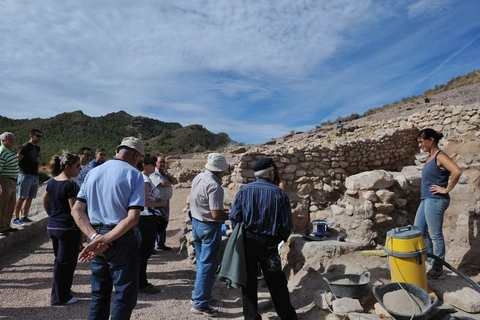 during the latter period of the culture. Analysis of seeds found indicates that these crops were mainly grown in dry land situations, and although it was produced in the agricultural areas was transported clean to the larger settlements for storage and distribution. Argaric houses typically contain raised “benches” on which storage jars would have held grain.
during the latter period of the culture. Analysis of seeds found indicates that these crops were mainly grown in dry land situations, and although it was produced in the agricultural areas was transported clean to the larger settlements for storage and distribution. Argaric houses typically contain raised “benches” on which storage jars would have held grain.
It is interesting to note that the distribution of agricultural implements recovered in burials shows that the production and processing of the crops appears to have been done in the agricultural settlements which have a higher proportion of threshing equipment and sickles in the burials, whereas tools relating to the processing and grinding of the cereals are found in much higher proportions in the larger settlements, such as La Bastida and El Argar.
The flour produced by grinding the cereals was used to bake bread and in other basic cooking processes.In the metallurgists house a clay oven has been rebuilt to demonstrate how bread would have been baked.
Beans and flax for linen were also grown in areas which could enjoy simple irrigation.
Seeds from olives, grapes, figs, berries and linseeds have been found in excavations, but there is no evidence that any of these were cultivated. Meat intake was mainly from livestock, such as sheep and goats, although there is evidence of hunted animals as well. Fishing was a probable activity in the seaside settlements, and remains of nets were discovered at the Punta de los Gavilanes site in Mazarrón.
There is also evidence of widespread use of esparto grass for weaving and manufacturing items such as baskets and ropes.
There are three main articles about La Bastida and the Argarics written:
Background to the Argaric culture, their customs and practices, technology, burials and general information. Click Argarics.
General information about La Bastida and this specific site, as well as some background information about the Argarics, Click La Bastida Totana
Information about the specific finds of this year, and the importance of the fortifications discovered.
Click Argaric fortifications at La Bastida.
Directions to La Bastida
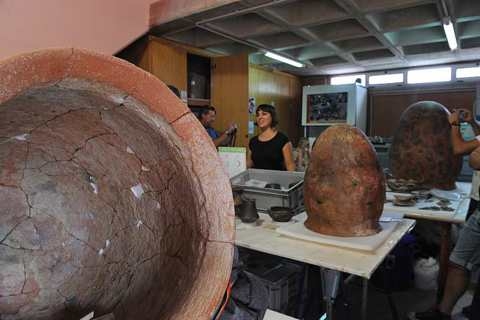 La Bastida is around 7km from the centre of Totana.
La Bastida is around 7km from the centre of Totana.
From the centre of Totana, drive across the bridge and turn left up Calle de la Santa Barbara, which then turns into Avenida de la Santa Eulalia, heading for the sanctuary of Santa Eulalia and the Sierra Espuña. The MU 502 road climbs up, out of town until it reaches a large, planted roundabout.
There is a sign for La Bastida on the roundabout, pointing round to the left. Follow this road down and keep your eyes peeled for turnings. After a good km, on the left hand side there is a signpost for Caliveti, ( but no sign for La Bastida) turn left and off down through the vineyards for several km.The road drops down, with greenhouses on the left and there is a signpost pointing to a turning on the corner, leading up to the site.
Where to eat if visiting La Bastida
There are a number of restaurants within easy driving distance if planning a visit to La Bastida. Click to go through to restaurants in Totana, from which well-priced lunchtime menus, snacks or evening meals can be obtained: Click Restaurants Totana
Images of tower structure courtesy of ASOME, remainder Murcia Today.





















